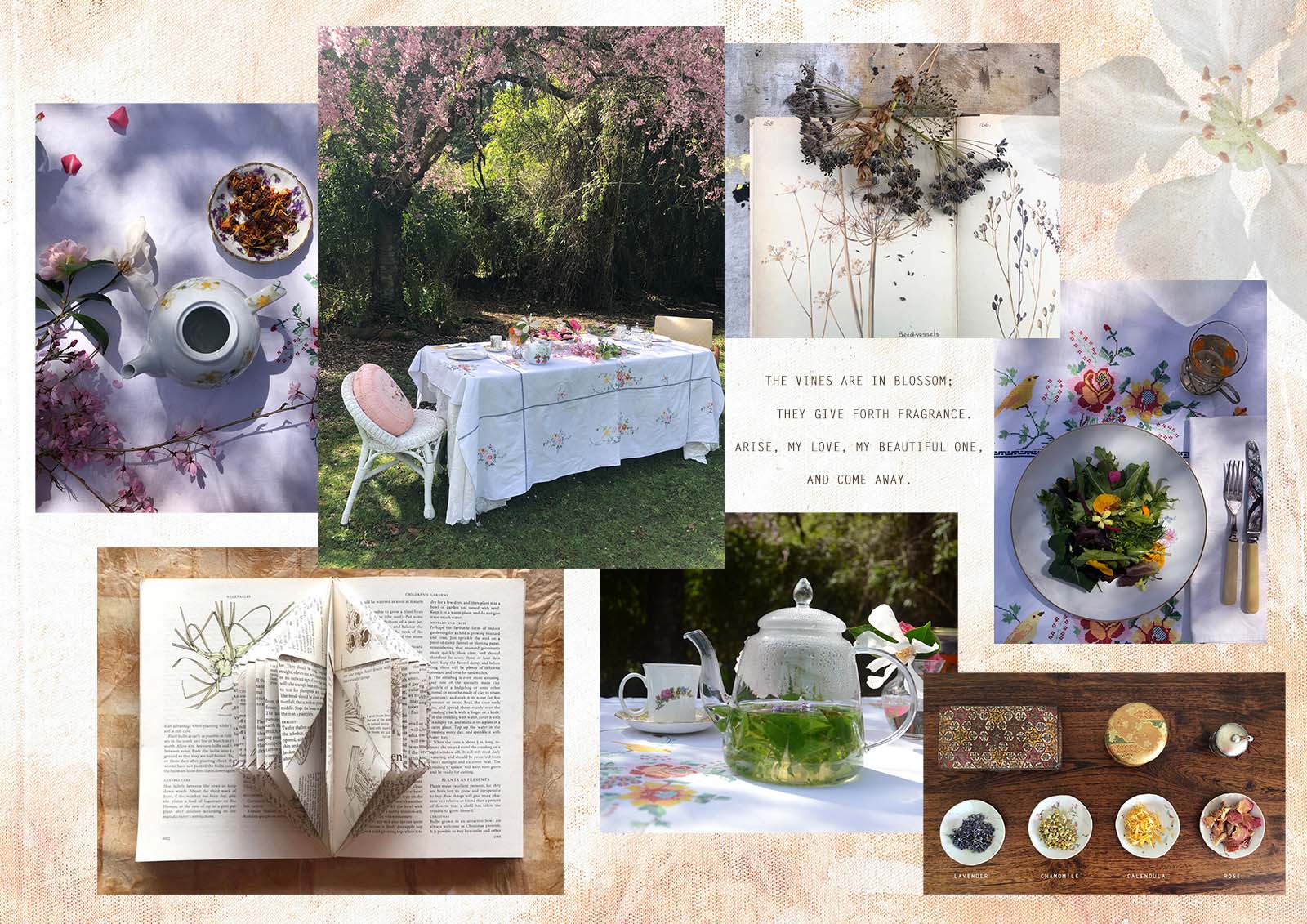Edible Gardens
There is nothing more deliciously rewarding than picking edible plants from your own garden. I grow specific plants in my garden for a multitude of purposes such as making my favourite herbal teas, and using edible flowers for making refreshing drinks, salads and decorating cakes, and utilising the abundance of homegrown fruits and vegetables for home cooking and preserves. As a garden designer, I always carefully consider the selection of plants for every unique design, incorporating a diversity of plants that are aesthetically pleasing but also useful in everyday life. Essentially organically growing your own edible garden is a more sustainable way of living, helps the environment and has a positive effect on our mental health.
Herbal & Medicinal Tea Garden
Who doesn’t love a good cup of tea, especially when it’s herbal! There are numerous health benefits to drinking herbal teas, that cleanse, nourish and heal our bodies, and there are some wonderful educational books to immerse yourself in. I highly recommend the book ‘Homegrown Tea by Cassie Liversidge’ to get you started.
Let’s not forget about the money you could be saving by having your own personally designed tea garden, and of course, everything always tastes fresher when you pick it directly from your own garden. Alternatively, you may be interested in drying your own herbs and collecting seeds from dried seedheads to store for teas in the winter months. I recycle pretty glass jars and forage for vintage tin boxes & canisters (with lids) to store my teas in, this way I get to have on hand an array of flavours right throughout the year. Drying plants for tea takes on a whole new aroma, and you can even experiment with a touch of spice for that distinct palate. Why not even consider setting up a whimsical table and chairs in your garden for those delightful morning or afternoon tea parties. Here’s my treasured brewed tea recipe (tonic for the brain, mental fatigue and stress):
Pineapple sage & Lemon zest herbal tea
1 cup Pineapple Sage, fresh leaves
¼ cup Mint, fresh leaves
2 tbsp Lemon zest
3 cups of water
Steep for 15 minutes
Flower Garden
You may be surprised to learn that you already have some edible flowers growing in your gardens such as geranium, rose, and lavender. I find joy in entering my garden just before lunchtime and picking myself a garden salad of mixed greens and herbs from the veggie patch, then adding seasonal flowers of, nasturtiums, sunflower petals and pansys, finishing with some dried fennel seeds, and a good squeeze of lemon juice – Bon Appetit!
What if I only have a small garden or space? You need not worry as I am an advocate for ensuring all landscapes both big and small are utilised to their greatest potential. You can plant edible flowers in pots and planters of varying heights and sizes, in a sunny courtyard or designated section of the garden. Incorporating edible flowers into the garden will also invite all the friendly and beneficial insects. A good note to keep in mind when selecting flowers for helpful insects is where the pollen is readily accessible to the insect, some suggested plants for you to start with are calendula, chamomile, and marigolds. Trust me when I say, your garden will be so much more divinely fragrant.
A word of caution, that it is very important to check reliable sources when eating flowers if you are ever unsure, or you can ask me!
Organic Veggie Garden
It seems that the trusty veggie patch has taken on a whole new level as of late. I say bring back the veggie patch to every household! There are so many reasons why, just to name a few – the food is local, fresher than ever, tastes more delicious, you know what is going into your food because you have total control, and there is less resource wasting which is a must if we want to take the best care of our environment. In the long run, you will save a lot of time and money, and who can say no to that! Trained in permaculture practices, one of the most rewarding and enjoyable benefits I receive from growing my own garden, is that I get to share my harvest with family and friends, bringing us all together. The joy and gratitude that it brings to everyone is truly priceless!
I like to use the no-dig garden method, which is essentially a patch above ground. As a great deal of soils in today’s time are nutrient deficient (a topic of conversation for another journal one day), the raised beds do not require soil beneath them to be dug over before installation. By using our own organic matter to fill the beds, it breaks down over time and the health of the soil improves the nutrient content, and microbial which creates a home for lots of wiggly worms.
Over many years, we have included homegrown techniques into our own landscapes and always begin by suggesting to all our clients if they have considered growing their own. It doesn’t have to be a big plot, just the right site, and it can be something small. I like to encourage you all to just get started if you haven’t, even if it is containers of herbs, or a raised veggie box for Pizza toppings that includes spinach, cherry tomatoes, baby eggplant, basil, rosemary & oregano, or you might want a productive lemon tree or bush food such as finger lime or mountain pepper.
Garden Consultancy & Design
Intermix Design offer services in consultancy and design for all types of garden requirements. If you would like to get started and include an edible garden in your space, please give us a call or drop us an email, and we can discuss your project further. Alternatively, you may like to purchase plants or seeds from our seasonal range by placing a custom made order specific to your needs. All the seedlings and seeds we use are old traditional open-pollinated and non-hybrid varieties of vegetable seeds, preferably old Australian varieties and organically or bio-dynamically grown where possible. These seeds have no chemical treatment and no genetic engineering.
There is nothing more rewarding than growing your own edible garden!
Happy gardening


Leave a Reply
Want to join the discussion?Feel free to contribute!